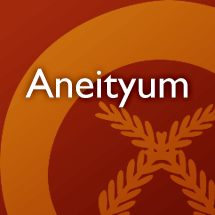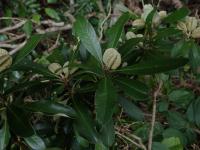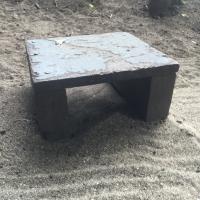An example search has returned 100 entries
ahlaujai
v.n. go up
bookmarkapuhod pan nathut an nadiat
n. near morning
bookmarkededel
n. spring
bookmarkelelehel
wind blowing
bookmarkincispev
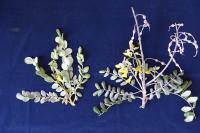
n. tree, 3 m tall (collection: Gregory M. Plunkett #3547)
Example: This plant is for medicine to treat a spiritual condition related to the coral snake that is the seawater spirit. When a woman is pregnant, some times she gets sick, so use this leaf with 2-3 other unspecified leaves and mash them together, squeeze the juice into a small cup (bamboo), wave around the woman’s body, and then put a few drops onto her head and body, then she drinks the rest. This will help heal her sickness. This treatment can be used for men who have a toothache from eating too much fish--the seawater spirit of the coral snake makes the tooth hurt. It is used in the same way as for a pregnant woman. If the pain from the toothache is really from the seawater spirit, then this will cure it; if not, it will not help.
bookmarkinharedej
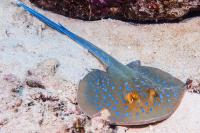
inhulec ~ iɣleɣ
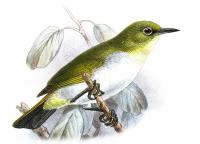
[inhuleɣ] n. Yellow-throated White-eye
Example: Illustration by John Gerrard Keulemans / Wikimedia Commons, License: Public domain via Wikimedia Commons
bookmarkinhuterau
n. a rainbow
bookmarkinlobot
n. croton plant
bookmarkinlopot jap
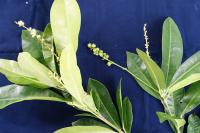
n. shrub to 1 m, flower white (collection: Michael J. Balick #4866)
Example: When making a taro patch, and removing soil, add the leaves of this plant to the soil to fertilize the taro, and prevent the bottom part of the taro from rotting. Put a layer of leaves on the bottom of the patch before planting taro and covering with soil.
bookmarkinmoupog
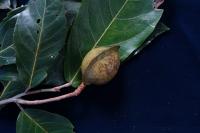
n. tree to 8 m, dbh 20 cm (collection: Michael J. Balick #4927)
Example: The wood of this tree is used as firewood. Children collect the dry fruits and use them for decorations and toys, for example playing with a fruit on the beach, driving it as if it were a toy truck or boat (photo).
bookmarkinran
n. a branch
bookmarkinrukdum nohos
n. kind of banana
bookmarkintejed
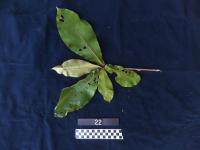
n. tree. Growing in village garden. (collection: Ashley A McGuigan #22)
Example: 1. Timber for houses, hard wood. 2. Fruits have a highly desirable nut that is edible when fresh after cracking the fruit. 3. Medicine – 5 young tips, boiled in 3 cups of water, and steam eyes when have conjunctivitis. 1x. 3. Calendar plant – When the leaves turn red and are ready to fall off from the tree – the lobsters are ready to be harvested – best time to harvest lobsters. Firm tasty meat. This was a traditional population management so that lobsters were not harvested year around but only during this season, Oct–Nov, for a month or 1.5 months.
bookmarkintel e cha
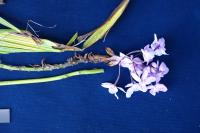
n. terrestrial orchid, growing in open (collection: Gregory M. Plunkett #3523)
Example: This is a "message plant." If a person puts the flower behind their ear and then stares out at you, or tosses the flower to you, then say yes and follow them, for example, to drink kava, or to go swimming. Or a man invites a woman to go somewhere with him. Alternatively, you can leave the flower on a table and this is also a message to go with a person. Leaves also used to wrap foods. Decorate yard around the house.
bookmarkinteses
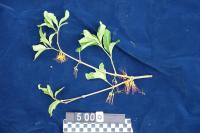
n. parasite in tree, flowers orange with reddish base. Growing in secondary forest. (collection: Michael J. Balick #5000)
Example: This plant is said to have a type of magical use. Young men take one node of the stem of this plant and use it in an unspecified way to attract young women.
bookmarkinvid
n. two days ago or two days hence
bookmarkinwah iran
n. seed
bookmarkinwai
n. kind of sugarcane
bookmarkinwoapeñ

inwowityuwun
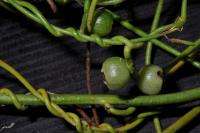
inwowityuwun
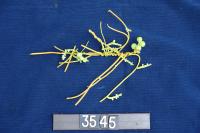
n. parasitic vine scrambling over Scaevola taccada, at edge of strand. Fruits green. (collection: Gregory M. Plunkett #3545)
Example: 1. Take a handful of vine, pound it and wash hair, like shampoo – makes hair curly and like rasta. 2a. This is a "message plant." If a person is walking through a village that is not his, people know that they come in peace. 2b. Message plant - if a group is discussing something and one person goes out and makes a head les of this vine, it means that there can’t be an agreement. 2.) If you are angry at a person, drop the vine at their door, in the case of a visitor or land dispute and they need to leave.
bookmarkinyipei
n. the flour, as of arrowroot
bookmarklelceije
v.n. to walk abroad
bookmarknacñanp̃aiñ
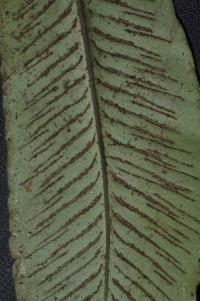
nadi adiat upni
nadiat
n. day
bookmarknadoni
n. prickly shrub
bookmarknahojcei
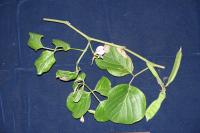
n. scrambling vine, growing in coastal strand vegetation. Flowers purple. (collection: Gregory M. Plunkett #3436)
bookmarknahraren nepig
n. dawn of day
bookmarknaipomyiv ~ naipomñiv
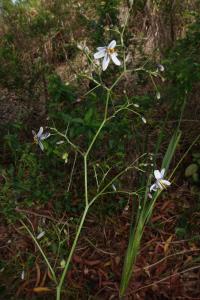
nakoai
n. species of palm tree
bookmarknala
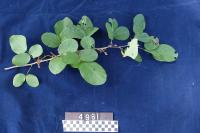
n. shrub to 2 m, coastal vegetation (collection: Michael J. Balick #4961)
Example: The stem of this plant is used for firewood. If a person has been drinking kava and the next morning feels hung over, they can take a handful of the leaves of this plant, crush them in cool water, and wash their face with this. This treatment will help the kava feeling to disappear.
bookmarknamniañia
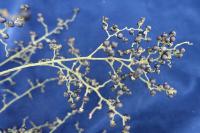
napannopotan
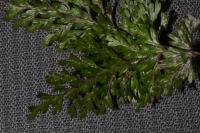
napau
n. kind of tree
bookmarknariramteh
n. kind of banana
bookmarknasiaij
n. a native plant, the leaves of which are used as cabbage
bookmarknauhap̃
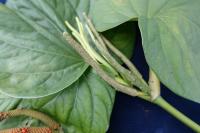
n. small tree or shrub, 2 m tall (collection: Gregory M. Plunkett #3210)
Example: 1. Use the leaves to put in a hole where taro is being planted, as a sort of fertilizer--it rots easily and adds value to the soil. To protect a person from spirits if you are going to an unfamiliar place, take the young inflorescence and put behind your ear. This plant is a sort of "spiritual kava." 2. Flowers are put behind one ear, any side, to allow a person to pass through sacred places. For protection of the spirits especially if you are familiar with this place. On EAST SIDE, put one leaf under pillow before sleeping so that the lady spirit will not disturb the person. Only for men – spirit likes men, and wants to have sleep with them. If she gets pregnant, you must follow her to look after the kids in the spirit world so you leave this one (you die). 3. The small, straight stems of this plant are used as rafters to weave thatch. 4. Children make bows and arrows from the stems as well as spears for fishing.
bookmarknaurakiti
n. kind of plant, grass, or fern
bookmarknausakrai
n. thorn
bookmarknauwainapit
n. lightning
bookmarknauyerop̃ u inman
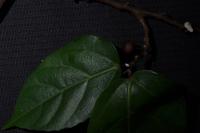
necemas moso
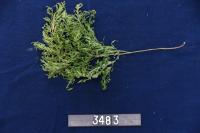
n. terrestrial plant on forest floor, growing in disturbed forest. (collection: Gregory M. Plunkett #3483)
Example: 1. This is a "message plant" that signifies that there has been a death. The person holds it or puts it on their head, goes to another person’s house and hands it to the person they wish to convey the message to, without saying anything and that person knows that someone has died. It can also be handed to that person. The person receiving the message then asks "who" and is told the deceased person’s name. 2. Use it to produce more fog on top of mountain – use w/ another plant, nap̃at (GMP 3268) – put these in a hole on the sacred stone to ferment as it fills with water. After it rots there will be a lot of fog. Name of stone = NAEMOSO. So the fog helps keep the plants moist and growing well.
bookmarknecñanjaa
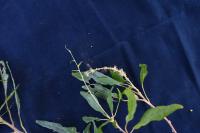
n. shrub to 2 m, dbh 3 cm (collection: Michael J. Balick #4862)
Example: The common name of this plant refers to the footprint of a chicken. Mix the dried leaves of this plant with pieces of coconut and feed to chickens. They are said to really like it. Plant the shrub near the place that chickens are kept. This feed will make the chickens produce more eggs and also increase the number of healthy chickens.
bookmarkneduwudu
adj. full of seeds, as the pawpaw apple
bookmarknefelelicai has
n. tares
bookmarknehlan
n. a shrub, a plant, a sucker
bookmarknehtumta
n. land newly planted with taro
bookmarkneipyepei
n. kind of tree
bookmarknejeg tau
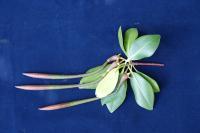
nelka
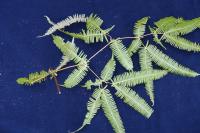
nelmaha
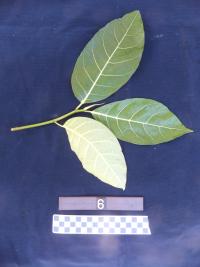
n. tree. Growing near village. (collection: Ashley A McGuigan #6)
Example: 1. To cure spirit sickness of the niteitau. Use plants that also end with "au" : niditau, intoutau, naoyerop. Go to the top of the plant to get the soft leaves of the plants niditau, intoutau, naoyerop, also take the bark. The person making the medicine should be holding the these leaves with a piece of nelmaha. Nelmaha means go away. The sick person chews the leaves and bark and swallows the juice spitting out the fiber into the nelmaha the medicine maker is holding. The medicine person then takes the spit out fiber in the nalmaha leaf and throws it into the sea in front of the village. 2. To cure headaches casued by bad spirit - Take one top from Nelmaha and one from inrowod (white stripe variety) Combine and chew these then spit them out and apply to the sick persons forehead. 3. To cure headaches - Someone other than the woman must prepare this. Break the top branch of netethae and remove leaves for use. Combine with the top leaves of the top branch of nelmaha. Chew the leaves and drink the juice. Do this when the sun is setting on the horizon. The woman gives the leftover fibers to the person who prepared the medicine and that person goes and throws the fibers in the direction of the setting sun. 4. To cure toothache when pregnant - Take the inner bark from Intejed and boil it in a pot of seawater (about 1 liter) along with 2 leaves from each of inpounatmas, narayag, nahayag, and nelmaha. Boil until juice is visibly leaving the plants. Put this water into your mouth and hold it there for 2-3 minutes. Do this this with one cup in the morning, 1 cup in the afternoon, and 1 cup in the evening. 5. Used to fight against black magic in an unspecified way. 6. Roll leaf and put in pocket for protection when walk in a new area. 7. Message plant if a land dispute – if a person puts this stem or leaf in another’s garden whom they are angry with it means go away!! 8. To treat sick people, especially who fall ill from black magic to save their life. Symptoms vary, for example a person with small boils over body,* a person chews the leaf and spits it on the sick person, 1x and then puts the branch with leaves near the sick person when they sleep – 3x (1x day) branch is ca. 25cm long. (*headache, severe)
bookmarknemeg
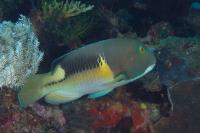
n. Anchor tuskfish, Orange-dotted tuskfish
Example: Photo by Mark Rosenstein, iNaturalist: CC BY-A-NC-SA 3.0 via Fishes of Australia
bookmarknepig sepahai
nepiloan
n. tender shoots
bookmarknerop
n. kind of banana
bookmarknese
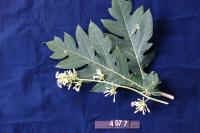
n. herb to 4 m tall, male flowers white (collection: Michael J. Balick #4977)
Example: The fruits are edible and eaten when ripe. To soften beef or octopus, or other meat that is tough, chop green fruit and put in a bowl with meat/fish and then add some water. Allow to sit for 30 minutes or if the food needs to be softer, then leave it in longer. The leaves are used to feed lobsters that are being kept in cages underwater, following their harvest. The leaves are used to cover stones on the earth oven. To treat a person with Ciguatera illness, wash many very gren fruits of papaya, the smallest ones that form at the top, and eat these to help relieve symptoms.
bookmarknihivai
n. Macaranga dioca
Example: Inner bark: bathe in cold infusion, wounds. Mix heated over fire and taken out during sunset. Healer clenches the package in his fist, then gently punches the patients left, then right knee, then his forehead and finally squeezes over his head, migraine a
bookmarknijilah
n. kind of tree
bookmarknispak
n. kind of sugarcane
bookmarknisyeg
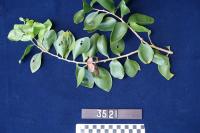
n. tree, 7 m tall (collection: Gregory M. Plunkett #3521)
Example: 1. The inner bark of this plant is used as a dye or paint to provide a brown color. Boil the inner bark in a pot with a shirt and the color of the shirt will be changed to brown. 2. For toothache, people take the inner bark and mix it with sea water, and then rinse the tooth with this mixture to remove the pain. 3a. People macerate the leaves and the bark and when the tide is low, spread this in a pool of water to poison the sea shells that are edible. When they die, the eyes of this organism comes above the sand, indicating where they are, and people harvest and eat them. 3b. To attract and collect clam – NIPJINUMU – scrape bark in a pool of sea water where the clams are attracted immediately and can be collected, coming up from the sand. 4. Firewood, unspecified medical use.
bookmarknohwan ajimta
n. kind of taro
bookmarknucsei
n. kind of taro
bookmarknupsin itai
n. seed
bookmarknupyihet
n. new moon
bookmarknuripapa
n. wind-related term; no definition provided
bookmarkpassion fruit
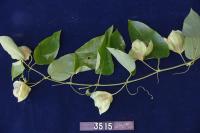
n. liana climbing on broken mango tree, growing in forest at edge of wide tidal stream (collection: Gregory M. Plunkett #3515)
Example: 1. The ripe fruit of this plant is edible. It was introduced to the island and is considered a foreign vine. 2. 4 leaves of this and 4 leaves of Annona muricata and boil in water and let get warm and wash children when they have measles and fever. Edible fruit – very sweet.
bookmarkumnad
adj. rotten, applied to fruit
bookmarkupumure
v.n. to fall, as unripe fruit
bookmarkuvid
n. three days ago; three days hence
bookmarkwamhau
n. kind of taro
bookmarkyatit
n. kind of banana
bookmark